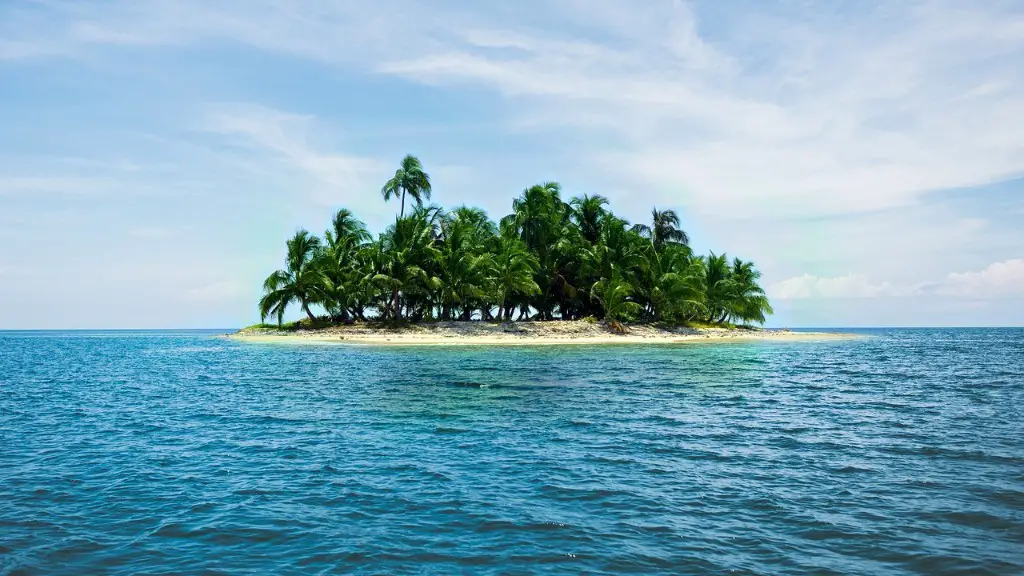From wealthy trading empires to a modern hub of international economic activity, the South China Sea has long been one of the world’s most important trade routes. Much of the global economic activity that passes through the region is done via the waters, making the South China Sea an invaluable source of commerce for countries that border it. With its vast maritime area, the South China Sea might very well be the busiest and most strategic body of water on earth.
On any given day, thousands of vessels transit the waters of the South China Sea. Tankers full of crude oil, container ships stocked with goods, and fishing vessels all traverse the area, forming a complex web of marine activity that touches the countries of the region in myriad ways. The waters of the South China Sea provide a conduit for vital resources, while also serving as a platform for communications, commerce, and cultural exchange.
Approximately 25% of the global trade ships transit through the South China Sea every year. This includes more than $3.37 trillion in goods from many different countries, including the U.S., China, Japan and South Korea. In addition, the South China Sea has one of the highest annual merchant ship transit densities in the world; with 30, 000 vessels passing through the region each day, the South China Sea has emerged as one of the busiest maritime areas in the world, rivaling even the Mediterranean Sea.
Part of the reason for the area’s commercial appeal is its strategic positioning. The South China Sea is halfway between major trading powers, allowing countries to access their markets quickly and efficiently. This makes the sheer variety of vessels that transit the area—oil tankers, container ships, and bulk carrier ships—extremely attractive to the countries along the area’s coastline, who rely on its waters to bolster their economies.
Despite the commercial benefits of trade through the South China Sea, the area has also been the site of much political tension and conflict. Countries such as China, Vietnam, Brunei, Malaysia, and the Philippines are involved in a complex, ongoing territorial dispute over the area. This has further complicated and limited the opportunities for economic development and trade in the region, and has limited global access to the area’s many resources.
The increasing tension and rising number of vessels that pass through the South China Sea have had a mixed impact on marine life. On the one hand, increased maritime activity has had a detrimental effect on migratory fish populations and other aquatic life in the area. On the other hand, this increased activity can be used to foster economic collaborations between countries in the region, as well as increase economic opportunity for countries that rely on tourism related to the area’s marine life.
Given its important position in global economic activity, it is clear that the South China Sea is an area of great economic and political importance. Despite the tension in the area, the importance of the region’s commercial activity should not be understated, and it is clear that the South China Sea has much to offer countries around the world.
Cultural Impact
The South China Sea also has a long history of cultural exchange and cultural influences on the region. For thousands of years, the South China Sea served as a conduit for the exchange of goods, ideas, and culture between the many nations that bordered it. This exchange of culture has had a strong influence on the cultures of the countries that make up the region, and many physical and intangible artifacts of the region’s history can still be found there. From iconic seafood dishes to unique styles of architecture, the South China Sea has touched many lives with its cross-cultural influence.
The influence of the region on culture spans beyond the countries that currently inhabit the area. Its influence has extended far and wide, with its spices and fashions being enjoyed around the world. In addition, the South China Sea has served as a major stopover point for traders throughout history, providing many with a chance to sample the culture of far-off locations. The area has historically been a hub of diversity and cultural exchange, making it an interesting destination for both locals and tourists.
The cultural influence of the South China Sea is primarily the result of its geography. Its unique location served to connect the region to bordering countries, making the exchange of culture and goods possible. This connection enabled the countries bordering the South China Sea to create a vibrant exchange of ideas and cultures. The maritime activities of traders and merchants sparked a dynamic cultural exchange that has made the region one of the most vibrant and diverse regions in the world.
In addition to being a hub of cultural exchange, the South China Sea plays an important role in the global community. The countries that border the region heavily rely on the waters of the South China Sea to conduct business and generate trading opportunities. The diversity of cultures present in the region has allowed for greater understanding between countries and fostered a greater sense of collaboration.
Environmental Effects
The environmental impact that the maritime activity in the South China Sea has had on the region is evident. One of the most significant impacts is the disruption of migratory fish populations. With increased vessel traffic, the waters of the South China Sea have become more turbulent and hazardous for aquatic life, resulting in a reduction of fish stocks in certain areas. This has had a considerable effect on the fishing industry in the region, as the waters are no longer able to sustain large amounts of fish.
In addition, heavy traffic in the region has caused a number of pollutants to enter the waters of the South China Sea, one of the most pervasive of which is oil spills. Oil spills are particularly dangerous to marine life, as they can contaminate both water and land. The consequences of oil spills can be devastating, as they can kill entire species of aquatic life or cause disruption to food chains.
The environmental impacts of maritime activities in the South China Sea have not gone unnoticed. In recent years, a number of environmental organizations have been working to reduce and manage the environmental damage caused by trade through the region. However, these efforts are often insufficient, as the oil spills and disruption of fish stocks continue to take their toll on the region’s delicate ecosystem.
In order to properly manage the impact of maritime activities on the environment, it is essential to have a comprehensive understanding of the region’s delicate ecosystem. Such knowledge can be used to identify the most effective mitigation strategies for reducing the environmental impacts of maritime activities, as well as helping countries in the region to better manage and protect their resources.
Political and Economic complexity
The political and economic complexity of the South China Sea has been an issue for centuries. With its various countries vying for control of the waters, the area has seen numerous military skirmishes and political clashes. In recent years, this has been compounded by a number of territorial disputes between the countries that border the region. As a result, the region has become a hotbed of political and economic tension.
The complexity of the South China Sea has also had an effect on its economic environment. With its vast shipping lanes and abundant resources, the area is a strategic hub of global economic activity. However, the political issues in the region have resulted in many countries becoming wary of engaging in economic activity in the area. This has resulted in a limited number of economic opportunities for countries in the region, as well as limited access for businesses to the resources of the South China Sea.
The solution to this economic complexity lies in engaging more countries in economic activities in the region. This includes inviting more countries to take part in resource extraction and maritime trade, as this could open the door for more economic opportunities for countries in the region.
It is also essential for countries to have stronger diplomatic ties with each other and to collaborate more on economic activities in the region. This includes building economic partnerships between countries in the region, as well as engaging in more joint initiatives that can help to promote economic growth in the South China Sea.
Finally, it is important for the countries involved to recognize the importance of the political and economic complexity of the South China Sea. This means understanding the importance of the region in global economics, as well as respecting the rights of all countries involved. This can help to foster greater understanding between countries and boost economic activity in the region.
International Stakes
The South China Sea is an area of great international importance. Its significance is magnified by the fact that it has some of the world’s busiest shipping lanes and is one of the world’s most important sources of trade. As such, the area has become a matter of great interest for many countries.
Many countries have sought to establish a presence in the area and to pursue their own interests. This has led to an increased security presence in the region, with many countries stationing naval vessels and other military personnel in the area. The presence of military forces has also had an effect on the security of the area, as an increase in military activity has had an adverse effect on some of the more peaceful and profitable activities that take place in the South China Sea.
In addition, countries with a presence in the area have sought to strengthen their presence by establishing exclusive economic zones, or EEZs. These zones are areas of the South China Sea that are off-limits to other countries and in which the country has exclusive control over the waters and all activities taking place within them. This has had a major impact on the international relations in the region as countries have sought to compete for economic and commercial advantage.
The international stakes in the South China Sea are high, with many countries vying for a presence and a say in the area. This has resulted in a complex political and economic environment, with many countries seeking to secure their own interests. As such, it is essential for countries involved in the region to be aware of the international stakes and to make sure that their interests are respected and protected.
Impact on Infrastructure
The impact of the maritime activities in the South China Sea on infrastructure has been significant. The increased vessel traffic in the region has made it a necessity for the bordering countries to invest in port and harbor facilities, as well as the necessary infrastructure for voyage routing, navigation, and communications. Additionally, the waters have also become more polluted, resulting in the need for improved sanitation and waste management.
The increased maritime traffic has posed a challenge for the countries in the region, as they have had to invest heavily in ports and other infrastructure. Nonetheless, the infrastructure investments have also provided economic benefits for the countries in the South China Sea. For instance, the presence of improved facilities has led to an increase in the number of vessels transiting the area, thus providing a boost to the local economies.
In order to maximize the benefit of the increased maritime activity in the region, better management is needed. This includes improved infrastructure and better monitoring of vessels. Additionally, investment in both infrastructure and marine life protection measures is necessary. This will help to make sure that the area is able to sustain its high level of maritime activity while also mitigating the environmental impacts of the activity.
Overall, the South China Sea is a vital hub of global maritime activity, providing countries in the region with





